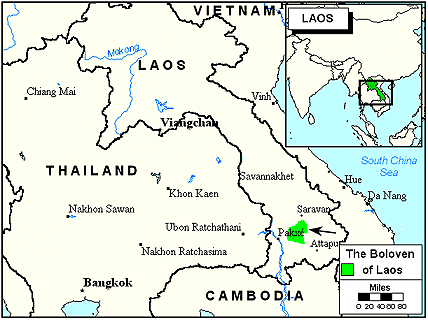|
|
Prayer Profile
The Boloven of Laos
![[IMAGE]](../images2/0428.jpg) The Boloven live in a fertile plateau area in southwestern Laos. At an elevation of approximately 3,500 feet, the plateau was once very productive. However, civil wars, poor transportation, and plant disease have combined to destroy coffee, cotton, and tobacco experiments.
The Boloven live in a fertile plateau area in southwestern Laos. At an elevation of approximately 3,500 feet, the plateau was once very productive. However, civil wars, poor transportation, and plant disease have combined to destroy coffee, cotton, and tobacco experiments.
The ancestors of the Boloven were part of the great Khmer empire that flourished from the ninth century to the thirteenth century. The empire, which encompassed present-day Laos, Thailand, Cambodia, and parts of Vietnam, declined after the Thai and Vietnamese invasions. The center of the Cambodian Kingdom, known as Angkor, was located in the Boloven region, where there are ruins dating from the eighth to the twelfth centuries. Laos has since been the scene of numerous battles and the object of political competition between China, Russia, and Vietnam. The Boloven are uniquely aware of other ethnic groups due to their contacts with the Lao, Chinese merchants, and European colonists.
What Are Their Lives Like?
Through the agricultural skills of the Boloven, an interesting economic network developed that helped them form a trade relationship with other people groups in Laos. They began to cultivate Irish potatoes, which were introduced by the French when Laos was part of French Indochina. Potatoes then developed as an important cash crop and placed the Boloven in an economic trade network involving Europeans and Chinese. Now, other tribal groups work for the Boloven and the produce is sold to Chinese merchants. They also cultivate rice, maize, peppers, yams, and other vegetables. Some spices, such as cardamom and cinnamon, are raised for export.
The Boloven are skilled wood-workers, though unlike other people groups in this area, they do not weave or work with metal. Pagodite, a stone used in carving, is also mined in the Boloven Plateau.
The Boloven live directly in the path of the southwest monsoon rains and receive more than 160 inches (4,000 mm) of rain, the heaviest rainfall in Laos. Boloven villages are generally small. Houses are rectangular, built on stilts, and accessed by stairs. Depending on a family's income, a house may have thatch or wooden walls, a thatch or tile roof, and bamboo or wooden floors. Each house has a kitchen garden in which vegetables and herbs are raised.
The village is the most significant political unit of Boloven society. Each has a village headman who decides important issues. Tribesmen are considered citizens of Laos, but most of them have no special representation in the government. Family leadership is directed by the eldest male.
The Boloven are somewhat unique in their marriage practices in that the couple must also give their consent (in addition to the parents) in order for the wedding to take place. There is no bride price, bride service, or dowry required for first marriages. If it is a second marriage, a bride price is given to the second wife's parents. The village headmen perform the weddings and provide a written document to make the ceremony official.
What Are Their Beliefs?
The influence of Buddhism is clearly seen in Boloven society, but it serves more as a veneer to their traditional ethnic religions, such as ancestor worship (praying to deceased relatives for help and guidance) and animism (belief that non-living objects have spirits). The Boloven believe that the ancestral spirits remain actively involved in their lives and should be cared for and fed. They are also strongly influenced by the belief that objects of nature, such as rivers, forests, mountains, and trees are inhabited by spirits who can directly influence the courses of their lives.
What Are Their Needs?
There are ample mineral deposits in the basaltic Boloven Plateau that have not yet been exploited and could offer promising opportunities for development. Although the plateau is well endowed with hydropower potential and aluminum ore, the absence of railways and inadequacy of the road network are major constraints. The government is hindered by insufficient resources, shortage of manpower, and inadequate knowledge and skills.
Prayer Points
- Pray that Christian laborers may gain access to the Boloven Plateau to preach the Gospel.
- Pray that missions organizations and churches will accept the challenge of adopting and reaching the Boloven people.
- Pray that the Jesus film and Gospel broadcasts will soon be produced in the Boloven language.
- Pray that the Boloven believers will rise to the challenge of taking the Gospel to their people.
- Pray that God will reveal Himself to the Boloven through dreams and visions.
- Take authority over the spiritual principalities and powers that are keeping the Boloven bound.
- Ask God to raise up prayer teams who will begin breaking up the spiritual soil of Laos through worship and intercession.
- Ask the Lord to save key leaders among the Boloven who will boldly declare the Gospel.

Statistics
Latest estimates from the World Evangelization Research Center.
THE PEOPLE
- People name: Boloven
- Country: Laos
- Their language: Laven (Jaru)
- Population:
- Largest religion:
- Christians: 2%
- Church members: 740
- Scriptures in their own language: None
- Jesus Film in their own language: None
- Christian broadcasts in their own language: None
- Mission agencies working among this people: 0
- Persons who have heard the Gospel: 8,200 (22%)
- Persons who have never heard the Gospel: 29,000 (78%)
THEIR COUNTRY
- Country: Laos
- Population:
- Major peoples in size order:
- Major religions:
- Number of denominations: 8
© Copyright 1997
Bethany World Prayer Center
This profile may be copied and distributed without obtaining permission
as long as it is not altered, bound, published
or used for profit purposes.
![[HOME BUTTON]](../graphics/home.jpg)
![[CALENDAR BUTTON]](../graphics/calico.jpg)
![[LIST BUTTON]](../graphics/listico.jpg)
[Home]
[Calendar]
[Country List]
|